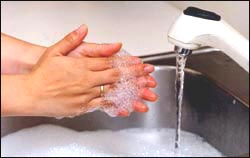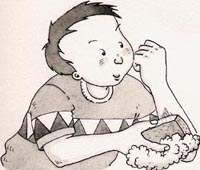화학물질이나 독성물질, 약물 등으로 생긴 피부 중독의 치료, Emergency treatment for spilling of chemical product, toxic product or drug on the skin
화학물질이나 독성물질,약물 등이 피부에 묻었을 때의 중독 치료의 개요
-
강한 산,
-
강한 알칼리,
-
쥐약,
-
탄화수소,
-
농약,
-
화학물질,
-
또는 약물 등이
사고로 피부에 묻으면 그로 인해 전신 중독, 피부 화학 물질 화상, 또는 피부염이 생길 수 있다 (화학물질 중독 예방 참조).
화학물질이나 독성물질,약물 등이 피부에 묻어 생길 수 있는 중독의 응급 치료

▴ 사진 1-37. 독극물이나 화학물질, 약물 등 유해 물질이 피부에 묻거나 눈에 들어가면 즉시
흐르는 수돗물이나 깨끗한 용기에 담은 물로 5-15분 동안 충분히 씻어낸다. 경우에 따라 샤워를 해서 씻어 한다.
Copyright ⓒ 2011 John Sangwon Lee, MD., FAAP
-
피부에 묻은 화학 물질 등의 종류에 따라 응급 치료방법이 다를 수 있다.
-
화학물질 등 유해물질이 피부에 묻으면 흐르는 수돗물로 적어도 5-15분 동안 깨끗이 닦는다. 그렇지 않으면 용기에 담은 깨끗한 물을 손바닥이나 컵으로 떠서 여러 번 흠뻑 씻는다.
-
상당히 해로운 화학 물질 등이 얼굴의 피부에 묻었을 때는 옷을 벗고 샤워 물로 얼굴을 5-15분 동안 흠뻑 씻을 수 있다.
-
여기서 가장 중요한 치료는 시간이다. 즉, 즉시 치료해야 한다.
-
Lithium, Sodium, Magnesium, Potassium 등 금속 원소 등은 물과 접촉될 때는 불이 날수도 있기 때문에 그런 종류의 화학물질이 피부에 묻었을 때는 물로 씻어서는 안 된다.
-
불화수소산(Hydrofluoric acid)이 피부에 묻으면 심히 아프고 피부가 심히 손상되기 때문에 찬물로 흠뻑 씻고 알칼리성 비누로 닦는다. 그리고 10% 칼슘 글루코네니트(Calcium gluconate/글루콘산 칼슘) 주사로 치료한다.
-
화학물질 등이 입은 옷에 묻었을 때는 피부에도 묻었을 가능성이 많기 때문에 묻은 화학물질이 더 이상 피부에 묻지 않도록 입은 옷을 빨리 주의해서 벗긴다. 독극물이나 화학물질 등이 묻은 옷은 벗어 버리든지 적절히 빤다.
-
그와 동시에 가능한 한 독극물 중독예방 응급치료 센터, 병원 응급실, 또는 단골 소아청소년과에 전화해서 그들의 지시에 따라 현장에서 응급치료를 한다.
-
의료구급대 등이 현장에 도착해 그들과 같이 병원 응급실에 환아를 이송할 때까지 화학물질 등을 담은 용기나 상자와 설명서 등에 따라 응급치료를 한다. 참고로, 때로는 화학물질 용기에 써 있는 응급처치 설명서에서 충분하고 적절한 정보를 더 얻을 수 없다.

▴ 그림 1-9. 화학물질, 약물 등 유독 물질이 사고로 피부에 묻으면
즉시 입었던 옷을 벗기고 수돗물 또는 용기에 들은 깨끗한 물로 오염된 피부를 깨끗이 씻는다.
화학물질 등의 종류, 묻은 정도와 신체 부위에 따라 흐르는 수돗물로 씻거나 샤워해서 씻는다.
때로는 용기에 담은 물로 씻는다. 그리고 의사의 지시에 따라 치료한다.
Copyright ⓒ 2011 John Sangwon Lee, MD., FAAP
-
가성소다(NaOH/Sodium hydroxide)나 가성가리(KOH/Potassium hydroxide) 등 알칼리성 화학물질이나 무기산 등 산성 화학물질이 등이 피부나 머리카락에 묻었을 때도 즉시 흐르는 수돗물, 샤워 물, 또는 용기에 받아 놓은 깨끗한 물로 5-15분 동안 충분히 씻는다. 때로는 시간을 더 절약하기 위해 옷을 입은 채로 샤워 하고 샴푸로 머리를 감는다.
-
이때 머리에 묻은 화학물질 등이 눈, 입, 콧구멍 속으로 들어가지 않도록 주의한다.
-
화학물질 등이 피부에 묻었을 때 언뜻 보기에 별 이상이 없는 것 같더라도 독극물 중독 응급치료센터나 단골 소아청소년과, 또는 병원 응급실에 전화 문의해서 그들의 지시에 따라 치료한다.
-
모든 종합 병원 응급실은 응급 치료 약물, 또는 화학물질 중독 응급치료 등 응급 전화 상담 치료에 즉각 반응하도록 나라 법으로 정하면 얼마나 좋을 까.
-
영유아의 피부에 화학물질 등이 묻었을 때는 화학물질 등을 마셨다고 간주하고 그에 해당한 응급치료를 적절히 한다.
-
화학물질 등을 마셨을 때 생길 수 있는 증상 징후가 나타나는지 관찰하고 화학물질 등의 중독 증상 징후가 나타나면 그 증상 징후에 따라 응급 처치를 한다. 박박 문질러 닦는 방법으로 피부에 묻은 화학물질을 씻어 내는 치료는 권장하지 않는다.
-
무엇보다도 중요한 것은 화학물질 또는 약물 등을 소아청소년들, 특히 영유아들의 손에 닿지 않게 안전한 곳에 평소 잘 보관해 화학물질 등으로 인한 독극물 안전사고가 또다시 생기지 않게 예방하는 것이다. [부모도 반의사가 되어야 한다–소아가정간호백과]-제2권 소아청소년 질병 안전사고 예방 참조.
Emergency treatment for spilling of chemical product, toxic product or drug on the skin
화학물질이나 독성물질, 약물 등으로 생긴 피부 중독의 치료
Overview of addiction treatment when chemicals, toxic substances, drugs, etc. are on the skin.
If your child’s skin can be accidently contacted by one of followings
- Strong acid,
- strong alkali,
- raticide,
- hydrocarbon,
- pesticide,
- chemical substance,
- or drugs,
- etc. can result in systemic poisoning, skin chemical burns, or dermatitis (see Preventing Chemical Poisoning) may be developed.
Emergency treatment of poisoning that may occur due to chemicals, toxic substances, drugs, etc. on the skin

▴ Photo 1-37.
If hazardous substances such as poisons, chemicals, or drugs get on the skin or get into the eyes, rinse thoroughly with running tap water or water in a clean container for 5-15 minutes. In some cases, take a shower to wash. Copyright ⓒ 2011 John Sangwon Lee, MD., FAAP
- Emergency treatment methods may differ depending on the type of chemicals on the skin.
- If hazardous substances such as chemicals get on your child’s skin, wash them thoroughly with running tap water for at least 5-15 minutes.
- Otherwise, pour the clean water in the container with your palm or cup and wash it several times.
- You can take off your child’s clothes and soak your child’s face in a shower for 5-15 minutes if your child gets a lot of harmful chemicals on the skin of your face.
- The most important treatment here is time. In other words, it must be treated immediately.
- Metal elements such as Lithium, Sodium, Magnesium, Potassium, etc., may ignite when they come into contact with water, so do not rinse with water when such chemical substances get on your skin.
- If hydrofluoric acid gets on your skin, it hurts and damages the skin so much, so wash it with cold water and wipe it with alkaline soap.
- And it is treated with an injection of 10% calcium gluconate. When chemicals get on your child’s clothes, it’s likely that they are also on your child’s skin, so take off your clothes quickly and carefully so that the chemicals do not get on your skin anymore.
- Take off clothes that have been exposed to poisons or chemicals, or wash them appropriately.
- At the same time, if possible, call a poison poisoning prevention emergency treatment center, hospital emergency room, or a regular pediatric and follow their instructions to provide on-site emergency treatment.
- Emergency treatment is provided according to containers or boxes containing chemical substances and instructions, etc. until medical paramedics arrive at the site and transfer the child to the hospital emergency room with them.
- For reference, sometimes more sufficient and adequate information is not available from the first aid instructions written on the chemical container.

▴ Figure 1-9. If toxic substances such as chemicals or drugs get on the your child skin in an accident, Immediately remove the clothes your child is wearing and wash the contaminated skin thoroughly with tap water or clean water in a container.
Wash with running tap water or shower depending on the type of chemical, the degree of smearing, and the part of the body. Sometimes it is washed with water in a container. And treat according to your child’s doctor’s instructions. Copyright ⓒ 2011 John Sangwon Lee, MD., FAAP
- When alkaline chemicals such as NaOH/Sodium hydroxide or KOH/Potassium hydroxide or acidic chemicals such as inorganic acids get on your skin or hair, use tap water, shower water, or clean water placed in a container immediately. -Wash thoroughly for 15 minutes.
- Sometimes, to save more time, shower while wearing clothes and wash your hair with shampoo. At this time, be careful not to let chemicals on your head get into your eyes, mouth, or nostrils.
- Even if there seems to be no abnormality at first glance when a chemical substance gets on your skin, call the poison poisoning emergency treatment center, regular pediatrician, or hospital emergency room and follow their instructions.
- How good would it be if all general hospital emergency departments were established by national law to promptly respond to emergency telephones counseling treatment, such as emergency treatment drugs or chemical poisoning emergency treatment?
- When chemicals, etc., are on the skin of infants and toddlers, it is assumed that they have drunk the chemicals, and emergency treatment is appropriate. Observe for signs, symptoms that may occur when you drink chemicals, and if signs of poisoning such as chemicals appear, take emergency treatment according to the symptoms.
- It is not recommended to use a thin scrubbing method to wash away chemicals from the skin.
- The most important thing is to keep chemical substances or drugs in a safe place out of reach of children and adolescents, especially infants, to prevent accidents of poisons caused by chemical substances from happening again. [Parents should also be at least the half-doctors-Child and Family Nursing Encyclopedia]-See Volume 2 Prevention of Child and Adolescent Disease Safety Accidents.
출처 및 참조 문헌 Sources and references
- NelsonTextbook of Pediatrics 22ND Ed
- The Harriet Lane Handbook 22ND Ed
- Growth and development of the children
- Red Book 32nd Ed 2021-2024
- Neonatal Resuscitation, American Academy Pediatrics
-
Childhood Emergencies in the Office, Hospital and Community, American Academy of Pediatrics
-
Emergency Medical Service for Children, By Ross Lab. May 1989. p.10
-
Emergency care, Harvey Grant and Tobert Murray
-
Emergency Care Transportation of Sick and Injured American Academy of Orthopaedic Surgeons
-
Emergency Pediatrics A Guide to Ambulatory Care, Roger M. Barkin, Peter Rosen
-
Immediate care of the acutely ill and injured, Hugh E. Stephenson, Jr
-
The Critically Ill Child, Diagnosis and Management, Edited by Clement A. Smith
-
Emergency Medical Services for Children: The Role of the Primary Care Provider, America Academy of Pediatrics
-
Quick Reference To Pediatric Emergencies, Delmer J. Pascoe, M.D., Moses Grossman, M.D. with 26 contributors
-
Manual of Emergency Care 응급환자관리 정담미디어
-
소아가정간호백과–부모도 반의사가 되어야 한다, 이상원
-
Neonatal Resuscitation American heart Association
-
Neonatology Jeffrey J.Pomerance, C. Joan Richardson
-
Pediatric Resuscitation Pediatric Clinics of North America, Stephen M. Schexnayder, M.D.
-
Pediatric Critical Care, Pediatric Clinics of North America, James P. Orlowski, M.D.
-
Preparation for Birth. Beverly Savage and Dianna Smith
-
Nelson Textbook of Pediatrics 14th ed. Beherman,
-
The Johns Hopkins Hospital, The Harriet Lane Handbook, 18th edition
-
Red book 29th-31st edition 2021
-
Nelson Text Book of Pediatrics 19th-21st Edition
-
Infectious disease of children, Saul Krugman, Samuel L Katz, Ann A. Gerhon, Catherine Wilfert
-
The Harriet Lane Handbook 19th Edition
-
소아과학 대한교과서
-
제1권 소아청소년 응급의료 참조문헌과 출처
-
Other
Copyright ⓒ 2015 John Sangwon Lee, MD., FAAP
“부모도 반의사가 되어야 한다”-내용은 여러분들의 의사로부터 얻은 정보와 진료를 대신할 수 없습니다.
“The information contained in this publication should not be used as a substitute for the medical care and advice of your doctor. There may be variations in treatment that your doctor may recommend based on individual facts and circumstances. “Parental education is the best medicine.”